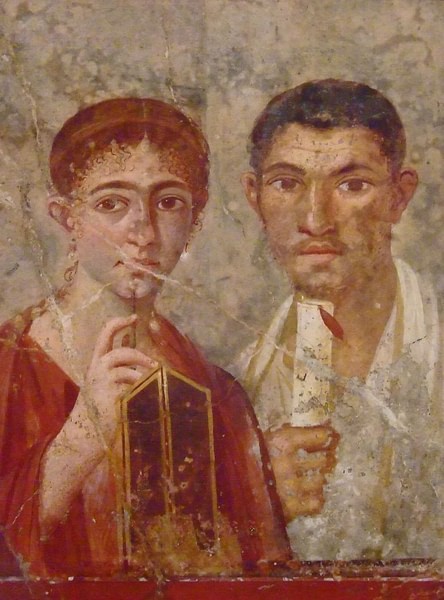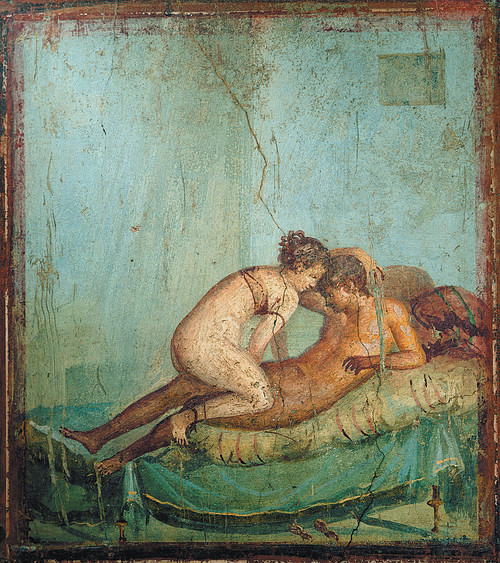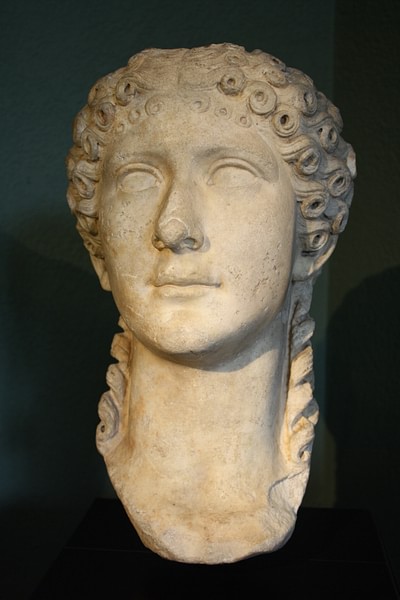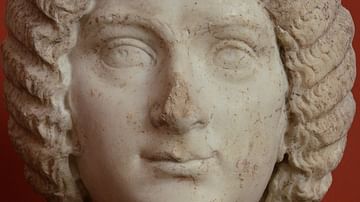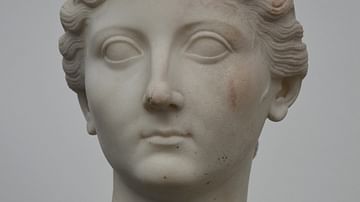The exact role and status of women in the Roman world, and indeed in most ancient societies, has often been obscured by the biases of both ancient male writers and 19-20th century CE male scholars, a situation only relatively recently redressed by modern scholarship which has sought to more objectively assess women's status, rights, duties, representation in the arts, and daily lives; and all this from almost exclusively male source material dealing with a male-dominated Roman world.
Women In Mythology
Unlike some other ancient cultures such as the Greeks who had formed a creation myth where woman was a creature secondary to man and, more specifically, in the form of Pandora, a bringer of unhappiness and vices, the Romans had a more neutral approach where humanity, and not specifically the male, was created by the gods from earth and water. Ovid's Metamorphoses, for example, does not specify whether the first human was a man or a woman. At least in a physical sense then men and women were not regarded as belonging to a different species as in the Greek world, a view often reiterated in Roman medical treatises.
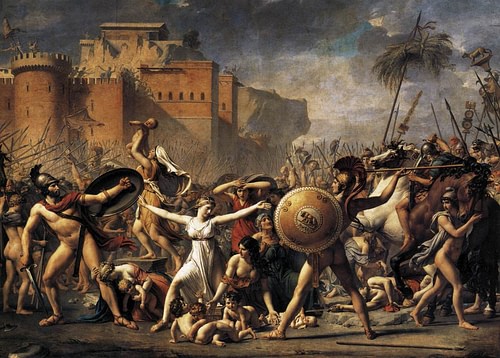
One of the most famous early episodes in Roman mythology that reveals much about attitudes to women is the Rape of the Sabine women. In the story, the first settlers of Rome abducted women from neighbouring tribes, taking them as their wives. One of the reasons for this action may have been a desire to form local alliances through blood ties. Naturally, these tribes sought to reclaim their women and so declared a state of war. However, the abducted women - led by Hersilia, the wife of Romulus - actually tried to intervene at this stage to prevent bloodshed. The story echoes the important role women played in linking families in Roman society - their family of birth and then of marriage.
Women & The Family
In many cases Roman women were closely identified with their perceived role in society - the duty of looking after the home and to nurture a family (pietas familiae), in particular, to bear legitimate children, a consequence of which was an early marriage, (sometimes even before puberty but typically around 20 years old), in order to ensure the woman had no sexual history which might embarrass the future husband. The Roman family was male-dominated, typically headed by the most senior male figure (paterfamilias). Women were subordinate and this is reflected in Roman naming practice. Male citizens had three names: praenomen, nomen, and cognomen, whilst all women in the same family were referred to using the feminine version of the family name. A married woman could keep her maiden name or be referred to using her husband's name (e.g. Cicero's Terentia). Within the family women would attend to the home and its slave workforce, work on handicrafts, and upper class females might also study academic subjects such as literature and philosophy.
This close dependence of women on their male relatives was also reflected in such matters as law and finance where women were legally obliged to have a nominated male family member act in their interests (Tutela mulierum perpetua). The only exceptions to this arrangement were women with three children (from c. 17 BCE), freedwomen with four children, and Vestal Virgins. This rule was designed to keep property, especially inherited property, in the male-controlled family, even if male and female offspring had equal inheritance rights under Roman law. However, in actual practice families may not always have followed the letter of the law in this area, just as with many other matters, and there is evidence of women running their own financial affairs, owning businesses, running estates etc., especially in cases where the principal male of the family had died on military campaign.
Another, even more chauvinistic explanation of this rule which allowed women to inherit and own but not control property was that they were thought incapable of managing such affairs for themselves. This view that women had weak judgement (infirmitas consilii) was expounded by Cicero, for example. Roman law did, though, at least stipulate that a wife's property be kept separate from her husband's (excepting the dowry) and it could be reclaimed following a divorce. Separation by divorce was easily achieved by both parties under Roman law but any children of the couple legally belonged to the father or nearest male relative if he was no longer living. In the later empire, and especially following legislation imposed by Constantine, divorce became much more difficult, especially for the female party.
Women In Wider Society
Roman women had a very limited role in public life. They could not attend, speak in, or vote at political assemblies and they could not hold any position of political responsibility. Whilst it is true that some women with powerful partners might influence public affairs through their husbands, these were the exceptions. It is also interesting to note that those females who have political power in Roman literature are very often represented as motivated by such negative emotions as spite and jealousy, and, further, their actions are usually used to show their male relations in a bad light. Lower class Roman women did have a public life because they had to work for a living. Typical jobs undertaken by such women were in agriculture, markets, crafts, as midwives and as wet-nurses.
Roman religion was male-dominated but there were notable exceptions where women took a more public role such as the priestesses of Isis (in the Imperial period) and the Vestals. These latter women, the Vestal Virgins, served for 30 years in the cult of Vesta and they participated in many religious ceremonies, even performing sacrificial rites, a role typically reserved for male priests. There were also several female festivals such as the Bona Dea and some city cults, for example, of Ceres. Women also had a role to play in Judaism and Christianity but, once again, it would be men who debated what that role might entail.
The Other Women
Roman women could be separated (not always absolutely clearly) between those who were considered respectable and those who were not. Many Roman males had the somewhat hypocritical stance that their female relations should be honourable and chaste guardians of morality while at the same time they were more than willing to avail themselves of the services of lovers and prostitutes.
To remind everyone of who was who clothes became a useful tool. Respectable women wore a long dress or stola, a mantle (palla) and had ties in their hair (vittae) whilst prostitutes wore a toga. If a respectable woman was found guilty of adultery, one of the punishments was to wear the toga. It is interesting that women were considered to belong either in one group or the other (there was no third category) but at the same time it was felt necessary to identify them with visual signs lest an embarrassing confusion occurred. The distinction between these two groups was not just a moral one for prostitutes and other lower class women had even fewer rights than women of a higher social status. Prostitutes and waitresses, for example, could not prosecute for rape and the rape of slaves was considered merely as property damage sustained by the owner.
Famous Roman Women
Some Roman women did rise above the limited role of family and household guardian that society prescribed and reached positions of real influence. Hortensia is one of the earliest. She, in 42 BCE, gave a famous speech in Rome's Forum in defiance of the triumvirate's proposal to tax the wealth of Rome's richest women to fund the war against Caesar's assassins. Other women who caused ripples in public waters were Cornelia (mother of the Gracchi brothers), Servilia (half-sister of Cato and mother of Brutus), and Fulvia (wife of Mark Antony). With the arrival of the emperors, their mothers, wives, sisters and even daughters could wield significant political influence and also large building projects often came to be sponsored by and dedicated to these women. One of the most celebrated wives of an emperor was Iulia Domna (170-217 CE), wife of Septimius Severus and mother of Caracalla. Iulia was given the title of Augusta and she was a noted patron of the arts, in particular, literature and philosophy. In her eventful life she had also been a priestess in Syria, travelled to Britain and, when Caracalla became emperor, she was given the impressive title of 'mother of the senate and of the fatherland'. In late antiquity there was the most famous female philosopher of ancient times, Hypatia of Alexandria. She wrote several treatises and became head of the Neoplatonic school in the Egyptian city but was brutally murdered by a Christian mob in 415 CE.
Conclusion
Roman law and social norms were, then, heavily weighted in favour of males but the full practical application of these laws and attitudes in specific cases is often difficult to determine, especially as almost all source material is from a male perspective, and an elite one at that. That women were regarded as inferior in legal terms seems clear but there are also countless texts, inscriptions, and even idealised portrait sculpture which point to the Roman male's appreciation, admiration and even awe of women and their role in everyday life. Roman males did not think women their equal but neither did they hate them. Perhaps the ambivalent attitude of Roman men to their women is best summarised by the words of Metellus Numidicus who was quoted in a speech by Augustus when the emperor addressed the assembly, 'nature has made it so that we can not live with them particularly comfortably, but we can't live without them at all'.
